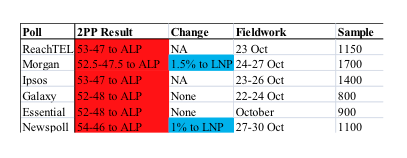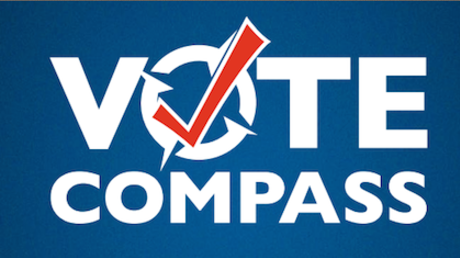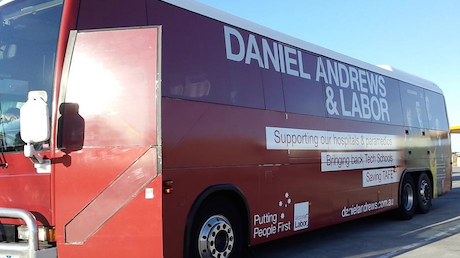All polls have the total Labor/Green vote at 50 per cent or more, and the Coalition vote at 40 per cent or less.
 While Victorians might be otherwise distracted by some other races, the Victorian Election is a mere four weeks away, and Labor is still very much the firm favorite.
While Victorians might be otherwise distracted by some other races, the Victorian Election is a mere four weeks away, and Labor is still very much the firm favorite.
The table (right) summarises the results of several polls that have been published in the last week, the most recent of them today's Newspoll. The columns are the polling company, the two party preferred (2PP) result, any swing from the last such poll by that company (if applicable), the dates that the poll was actually in the field, and the poll’s sample size.
The table uses the pollster’s 2010 election preference flow 2PP as the table figure. Ipsos (for Fairfax) actually reported a headline figure of 56-44 to Labor, but this was based on respondent allocation of preferences. ReachTEL and Ipsos are recorded as "not applicable" in the “Change” column because this is the first Fairfax Ipsos poll, while ReachTEL has not conducted a Victorian poll since 2013. Note that Newspoll’s fieldwork dates are later than the other polls.
I am uncertain about Morgan’s figures. His last poll had Labor leading 54-46 from almost the same primary vote figures as this one. Morgan was criticised after his last SMS polls because his NSW and Queensland polls did not account for optional preferential voting in those two states. He may now be using the previous election’s preference flows for all his state polls; in this case, Labor’s decrease is explained by the change of methodology from respondent allocation to previous election.
On primary votes, all polls have the total Labor/Green vote at 50 per cent or more, and the Coalition vote at 40 per cent or less. The Greens had primary votes of 18.5 per cent in Morgan and 17 per cent in Ipsos, but in the other four polls the Greens’ primary vote was 12-13 per cent. At past elections, pollsters have overestimated the Greens’ vote, and it is unlikely that the Greens are really at 17-18 per cent. Labor’s primary vote was in the high 30’s in all polls except in Morgan (34 per cent) and Newspoll (41 per cent).
It is clear from these numbers that Labor would win an election held now. In fact, it is probable that the 2PP figures in the table are underestimating Labor’s actual 2PP given current primary votes. As I argued in my previous Election Watch article, Greens preferences are likely to be stronger for Labor than in 2010 due to anti-Abbott sentiment. The preference flows to Labor in Victoria at the 2013 Federal election were also better than at the 2010 State election. In summary, Labor remains the clear favourite to win the State election in four weeks.
It's interesting to dig down into the polls to see voter attitudes on specific big issues in the Victorian contest. Robopollster ReachTEL asked whether voters support the East West Link in isolation, and found 48 per cent supported it, with 30 per cent opposed. They also asked if Labor should cancel the Link if it won government, and found that voters were opposed to cancellation by a 49-27 margin.
Galaxy Research asked whether voters would prefer the East West Link, or Labor’s policy of removing 50 level crossings. They found that 58 per cent thought higher priority should be given to removing level crossings. Unfortunately, there is no table in the linked article, so we do not know the exact question wording or how many said they preferred the East West Link as a priority.
Notes on These Polls:
- ReachTEL’s voters gave Premier Denis Napthine a 30 per cent good or very good rating and a 39 per cent poor or very poor rating. Opponent Daniel Andrews had 23 per cent rating him good or very good and 39 per cent poor or very poor. The net approvals are thus -9 for Napthine and -16 for Andrews. ReachTEL’s approval ratings have a middle option of “satisfactory”, which hides some weakly positive ratings. As a result, ReachTEL’s ratings are hard to compare with those of other pollsters.
- Galaxy is a phone pollster, and it gave Napthine a 43-27 lead over Andrews as preferred Premier, up from 41-33 in August. Preferred Premier or Prime Minister ratings almost always favour the incumbent more than the poll’s 2PP results, and the media focuses on them much more than they are worth. In this Galaxy, there are 30 per cent who cannot decide who would be their preferred Premier, and it is likely that these would heavily favour Andrews if pushed. Indeed, Morgan asked a forced choice preferred Premier question, and found that Napthine was only ahead by 52-48.
- Ipsos is a phone pollster, and it gave Napthine an approval rating of 47 per cent and a disapproval rating of 38 per cent, for a net approval of +9. Andrews had 37 per cent approving and 42 per cent disapproving for a net approval of -5. Napthine’s approval ratings are an asset for the Coalition. According to voters, the three most important issues were health, education and jobs, and Labor led the Coalition on all these issues by between10 and 24 percentage points. Financial management was the fourth most important issue, and here the Coalition led by 27 points.*
- Essential uses an online panel for its polls. It reports Federal polls every week, but they are seen as too stable.
- Morgan’s first SMS poll of state voting intentions was conducted in late September. There have been few SMS only Morgan polls, and it remains to be seen how they will perform.
- Newspoll had Napthine’s satisfied rating up 6 per cent to 46 per cent and his dissatisfied rating down 2 per cent to 41 per cent for a net approval of +5, up from -3 in July-August. These ratings are good, but not spectacular. Andrews had a satisfied rating of 36 per cent and a dissatisfied rating of 45 per cent for a net approval of -9, with both satisfied and dissatisfied scores up 4 per cent from July-August. Labor holds a 53-26 lead on best party to manage education, and a 48-31 lead on health, but trails 49-31 on the economy. These issue questions were also asked shortly before both the 2006 and 2010 elections, and Labor has recovered to where it was in 2006 after a 2010 slump on all issues except the economy, where the Coalition has clearly benefited from incumbency. Newspoll is a phone pollster that is very well known for its Federal polls.
*Source for some of Ipsos’ figures: The Age, 30 October 2014, tables on pages 4-5
Adrian Beaumont is a PhD student at the University of Melbourne’s Department of Mathematics and Statistics and a regular contributor on political polls for The Conversation.




